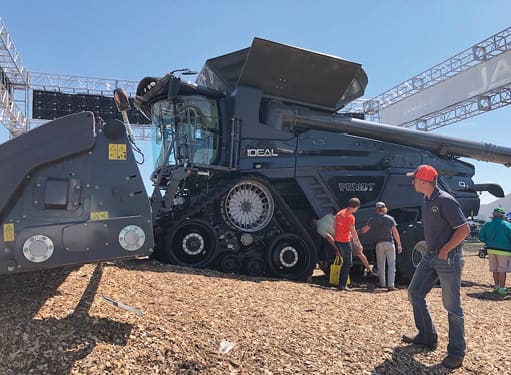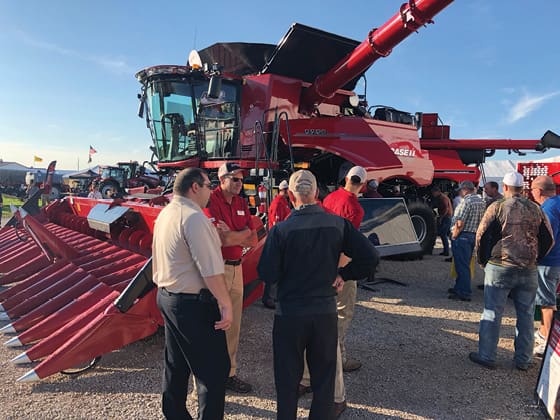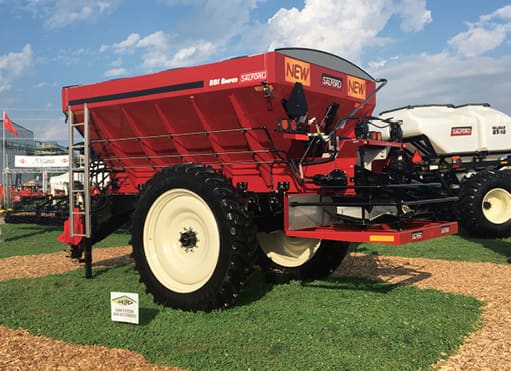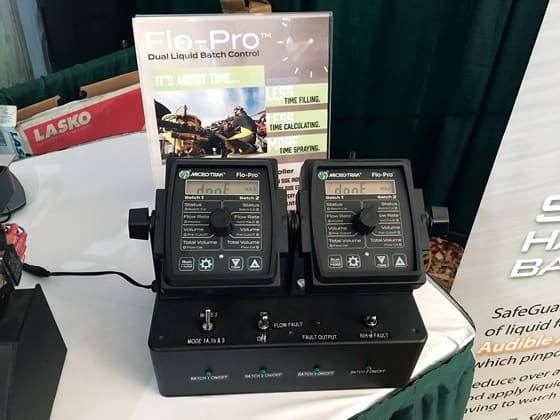A No-Till Farmer Staff Report
No-Till Farmer sent 11 staffers to the Farm Progress Show in Boone, Iowa, to cover the latest equipment innovation trends in the no-till market. What follows are the most noteworthy product launches, industry notes and trending news editors found impacting the North American ag market. For more on what our editors saw, heard and experienced on the show grounds, visit No-Till Farmer’s Facebook and Twitter pages (#FPS18). You can also find additional coverage and exclusive video interviews on www.No-TillFarmer.com.
AGCO’s Ideal Combine Draws Crowds

 Perhaps the biggest story line at the show was AGCO’s new Fendt Ideal combine. After AGCO first revealed the machine earlier this summer at the Canada Farm Progress Show in Regina, Sask., the company had three of them on display in Boone. This was a good thing, said company officials, given the constant crowd that the combines were attracting to the AGCO tent.
Perhaps the biggest story line at the show was AGCO’s new Fendt Ideal combine. After AGCO first revealed the machine earlier this summer at the Canada Farm Progress Show in Regina, Sask., the company had three of them on display in Boone. This was a good thing, said company officials, given the constant crowd that the combines were attracting to the AGCO tent. AGCO says the company has spent 7 years developing the product up to this point. The development process included farmer and dealer feedback at every step. The design of the Ideal essentially started from scratch, the first such “clean sheet” axial combine in 30 years.
In an interview with No-Till Farmer editors at the Farm Progress Show, Bob Crain, AGCO senior vice president and general manager, Americas, says the new combine will be rolled out slowly. Only 11 dealers will initially sell the Ideal, with more dealers added in the fourth quarter, with possibly around 100 dealers carrying it by 2019, he says. The Ideal is expected to be fully rolled out in 2020.
New Selenium Vacuum Seed Meter

 Brazilian manufacturer J.Assy made its second appearance at the Farm Progress Show and introduced its new Selenium vacuum seed meter, which has kits for soybeans and sorghum. The company is partnering with planter row unit manufacturer Harvest International for production.
Brazilian manufacturer J.Assy made its second appearance at the Farm Progress Show and introduced its new Selenium vacuum seed meter, which has kits for soybeans and sorghum. The company is partnering with planter row unit manufacturer Harvest International for production.“One of the key differentiators with the product is with crop changeover,” says Dale Simpson, general sales manager for J. Assy. “When changing from one crop to another, it’s as simple as popping out one kit and replacing with another one, without adjusting singulators, knock-out wheels or small pins.”
The company also showcased the Visum wireless flow blockage system for strip-till fertilizer application. Working with Montag Mfg., for distribution, the system is wireless and consists of a hose sensor, vibration flow detection and in-cab monitor.
If there is a blockage in the boot of the row unit or in the meter, the operator will get an audible indication of the plug in the row, and which row, says Simpson.
“Many farmers running dry fertilizer application in a strip-till system are doing so without any real indication of knowledge if they are getting flow to each row unit,” Simpson says. “I liken it to there not being a farmer around who wouldn’t have a monitor on his seed meter for the corn planter, so why wouldn’t you want to have the same kind of tracking with dry fertilizer application.
Cost of the system is $260 per row, and available on a variety of strip-till row unit models, Simpson says.
First Blockage Monitor for Floaters Debuts
Fargo, N.D., based Intelligent Ag Solutions debuted its Recon SpreadSense blockage monitor for floaters, the first system of its kind in the ag industry. The technology uses adhesive, acoustic sensors that attach to the back of sensor deflectors.
The sensors “listen” to material flow and send sound pulses through auditory tubes, similar to a stethoscope, says Matt Grove, product manager. Data is then collected by the electronic control unit (ECU) which displays information on an iPad in the tractor cab.
“This is the first blockage sensor for dry fertilizer products for pneumatic boom machines,” Grove adds. “The readout has a mass flow number to show the operator how product is flowing through the machine and also easy ways to identify blockages through green and red graphs on the bottom of the interface.”
Case IH Launches New 250 Series Combines, Harvest Command

 Case IH introduced its Harvest Command, automated technology on the new 250 series combine for 2019. Ryan Blasiak, harvesting marketing manager, summed up the new developments. The standard-issue AFS Connect allows dealers to better diagnose and be aware of service intervals to help customers in downtime/update.
Case IH introduced its Harvest Command, automated technology on the new 250 series combine for 2019. Ryan Blasiak, harvesting marketing manager, summed up the new developments. The standard-issue AFS Connect allows dealers to better diagnose and be aware of service intervals to help customers in downtime/update. “For farmers, we can use 16 different sensors to make 7 different, key combine function changes,” Blasiak explains. “These include ground speed, rotor speed, pre-sieve, top-sieve, fan speed, lower-sieve and then ultimately now, cage vane angle position as well.”
The new system also features an exclusive, patented, sieve pressure sensor to measure pressure differential between the upper and lower sieve to get a better readout on sieve operation for operators. “Farmers can know if they have a sieve off-loss condition or blowout losses and then the sensors constantly optimize the machine before losses occur,” Blasiak says. “This helps maximize grain savings and benefit to the customer.”
The Harvest Command starts at about $13,000 list price. Additional 250 series combine updates include enhancements to the feeder house (fore-aft adjustments) top shaft assembly area, support for heavier heads and narrow-row chopping heads and optional in-cab adjustments to change the position of the cage vane angle to slow or accelerate grain material through the combine and the technology offering.
xarvio Introduces Weed, Disease Detection to North America
Germany-based xarvio Digital Farming Solutions introduced its new scouting app, with image recognition technology to identify — with near 90% certainty — 11 known diseases and 11 weed species in the U.S. Farmers have the ability to take an early-stage, in-field photo and cross-reference the image in the scouting apps database to identify the disease or weed.
Based on several hundred thousand images and machine learning algorithms, the app also assigns a “confidence index” percentage with the classification,
“We plan to have the U.S. model available in 2019 for corn and see the potential to apply the same technology to ground-based sprayer rigs, to recognize and adjust spraying to only target weeds,” says David Gray, U.S. commercial manager.
360Sprint Seeks to Set Pace of Fertilizer Refilling

 360 Yield Center debuted a prototype of its new 360Sprint machine, designed for on-the-go liquid fertilizer refills. A 300-gallon tank, mounted on a John Deere Gator, has a connector in the front that can attach to a moving planter in the field and refill liquid nitrogen or starter fertilizer on the planter. With the ability to cover as much as 30% more acres in a day, the company field tested 4 machines this spring including on founder Gregg Sauder’s farm.
360 Yield Center debuted a prototype of its new 360Sprint machine, designed for on-the-go liquid fertilizer refills. A 300-gallon tank, mounted on a John Deere Gator, has a connector in the front that can attach to a moving planter in the field and refill liquid nitrogen or starter fertilizer on the planter. With the ability to cover as much as 30% more acres in a day, the company field tested 4 machines this spring including on founder Gregg Sauder’s farm.“Farmers are spending a lot of money on high-speed planters and to be sitting as much as 12 minutes to refill fertilizer, as much as 10 times per day, that’s more than 100 acres a day lost on pitstops,” Sauder says. “This system can load 300 gallons in less than 4 minutes and we see broader use with farmers looking to chase strip-till bars in fall to add liquid N.”
Autonomy Continues to Advance
Ames, Iowa, technology developer Smart Ag unveiled its AutoCart autonomous technology. Designed to assist with labor shortages on farms, the aftermarket kit can be implemented into the cab of a combine during grain harvest to control a tractor in a separate part of the field.
The system comes with an additional remote farmers can use to stop the tractor immediately when needed. With price points estimated between $35,000-$40,000, AutoCart is currently being run on a limited scope with John Deere equipment and anticipated for a full commercial release in 2019, according to Mark Barglof, chief technology officer for Smart Ag.
“Right now, the system works for 8R series tractors, but as we continue into the future we plan to increase the types of equipment the system can run on it,” says Barglof. “We’ve got partnerships with Bottom Line Solutions in Illinois, and AgriVision, a local Deere dealer.”
Salford BBI Sniper Debuts

 Newly released at the show from Salford Group, the BBI Sniper spinner spreader offers targeted dry fertilizer application at widths up to 120 feet and uses patent-pending technology to follow prescription application targets by rapidly adjusting its spread pattern on the fly.
Newly released at the show from Salford Group, the BBI Sniper spinner spreader offers targeted dry fertilizer application at widths up to 120 feet and uses patent-pending technology to follow prescription application targets by rapidly adjusting its spread pattern on the fly. Brad Baker, senior product manager with Salford Group notes the system features section control allowing the unit to apply in 12 sections, starting with a 40-foot spread pattern.
“It is independently controlled on both sides, by a bed chain conveyer on both sides of the hopper, feeding individually controlled spinner spreaders,” Baker says. “Also featured is the dynamic calibration system, which integrates the scale system into our controller.”
The proprietary ISOBUS controller allows operators to calibrate the machine on the fly. This includes taking regular scale readings, feeding the differential in weight in the hopper into the controller and making the calculations to recalibrate to the desired rate.
The system will have a limited release in 2019 model year and the technology will be applied to other BBI product lines and spinner spreaders, including both pull-type and chassis mount products.
Micro-Trak Flo-Pro

 Rex McClellan with Micro-Trak Systems debuted the new Flo-Pro Batch meter, which can monitor 2 batches of chemical injection or tank transfer by setting the monitor for volume amount, and then counting down digitally for an automatic shut-off.
Rex McClellan with Micro-Trak Systems debuted the new Flo-Pro Batch meter, which can monitor 2 batches of chemical injection or tank transfer by setting the monitor for volume amount, and then counting down digitally for an automatic shut-off.“The monitors will count down the volumes then automatically shut off either an electric pump or a 12 volt shut off valve,” McClellan says.
The systems are available with a list price of $875 for the console, plus the cost of whatever size flow meter is needed for the farmer’s operation.
OEMs Broaden Base of Factory-Direct Precision
Ag equipment manufacturers continued the trend of integrating more precision technology into equipment from the factory, expanding inclusions to include more data-centric tools. Case IH announced the inclusion of its AFS Connect portal for model year 2019 base models of its 250 combine series, Magnum and Steiger tractors. The 1-year subscription, priced at $500, allows for file transfer and review of collected agronomic and machine data, says Chris Dempsey, Case IH marketing manager.
John Deere also expanded its precision features in base large ag equipment for 2018, with inclusion of its AutoTrac Universal 300 steering system ($3,000 list price) and software updates to its Gen 4 displays. With the frequency that farmers trade equipment, `
Matt Olson, precision marketing manager for Deere, says inclusion of precision hardware and software is expected on sales of used equipment. “Activations are just as attached to that equipment as the steering wheel and tires,” he says. “For dealers, it simplifies the sales process and provides more value to that used equipment.”
New insecticide, Micronutrient Offerings
Verdesian Life Sciences introduced its new MicroSync Granular Micronutrients. The product is manufactured in a new process called Nutripaction. “We have five different blends depending on what the grower’s needs are in their fields,” says Kevin Bodensteiner, technical sales representative for Verdesian.
The process takes products in their simplest forms, packs them together through Nutripaction and then grinds it into a granular form that has a similar density to potash, providing an even spread. To help with crop uptake, they have also incorporated polymer technology.
Also debuting at the show was Syngenta’s new insecticide formula, Force 6.5G. This higher-loading granular formation results in half as many bags to load and haul. “A 40-pound bag of Force 6.5G treats 175% more acres than the prior formulation,” said Meade McDonald, Insecticide Product lead at Syngenta.
Also, Corteva Agriscience announced the full launch of their Enlist Weed Control system following the launch of Enlist Corn. “Enlist Corn allowed our farmers a couple different options that they haven’t been able to have before and that’s the ability to use our new 2,4-D choline in Enlist One and/or Enlist Duo in crop,” said Andy Fordice, category lead at Corteva Agriscience. This helped farmers to control some weeds that may have been escaping in prior systems.
The new Enlist weed control system includes a new product for corn called Assure II which provides another control tool against grasses and volunteer corn. Fordice also mentioned the Enlist soybean system and how it provides no-till farmers with a tool to control tough weeds with the use of 2,4-D, glyphosate and glufosinate. These soybeans have shown tolerance to three different herbicide trait mixes which allows for achieving higher yields.
For more on editors’ observations at the Farm Progress Show, tune into the “Farm Progress Show” video series available on www.No-TillFarmer.com.







Post a comment
Report Abusive Comment